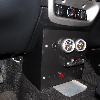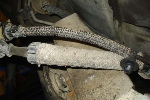Here is a reprint of that article:
VMTP NEWS
New Ford Transmission
5R44E & 5R55E
Courtesy of Bob Cherrnay
Technical Editor - Transmission Digest
Beginning with the start of production for 2001, Ford Motor Co. introduced a new-model transmission with the designation 5R44E, a five-speed transmission that replaces the previous-design 4R44E. This new 5R44E model, like the 5R55E transmission, has an added intermediate-shaft-speed (ISS) sensor.
Changes were also made to the PCM strategy, which now includes shift-adaptive pressure-control strategy. The 5R44E transmission is used in 2001 Rangers with 2.3L and 3.0L engines, and the new design 5R55E transmissions are in the Ranger, and Explorer models with 4.0L engines.
The 5R44E transmission was added to establish a commonality among transmission models, and the ISS sensor was necessary for the new PCM shift-adaptive pressure-control strategy. Some parts changes have been made to these new units. NONE of the parts listed are interchangeable with the previous design level parts.
Transmission Case - New transmission case casting, and machining to accommodate the added ISS sensor.
ISS sensor - This provides additional information for the PCM to determine various incremental pressure changes to minimize the difference between the actual, and ideal shift timing for shift-adaptive pressure control strategy.
Sun Shell - Now manufactured with windows, and used to trigger the added ISS sensor.
Powertrain Control Module - Operational changes that includes shift-adaptive electronic-pressure-control strategy.
Shift-Adaptive Electronic-Pressure-Control Strategy-
This strategy allows for improved control over the transmission shift events. On the basis of various input signals, the strategy calculates an actual shift time, and compares it with an ideal shift time. Once the vehicle is up to operating temperature, incremental pressure changes are made to minimize the difference between actual, and ideal shift times. Over time, the adaptive learning process will fully update keep-alive memory (KAM). The more varied the driving habits, the longer the update will take. However, the adaptive learning process will also be more complete. Adaptive pressure control strategy is capable of adapting upshifts, closed-throttle downshifts, and garage shifts. For diagnosis of the ISS sensor see below.
If for any reason the vehicle loses power to the KAM, the transmission will return to its present level. Reasons for this happening are a disconnected or fully discharged battery, PCM disconnected while the battery is still connected, or updated calibration programmed into the PCM.
5R44E/5R55E added diagnostics, and trouble code chart:
DTC Description Symptom Possible causes
P0791 ISS sensor failure
[signal loss]
Harsh 2-3 shifts
ISS sensor or wiring
P0794
ISS sensor signal
intermittent
Harsh 2-3 shifts
ISS sensor or wiring
P1636 SSx ISIG
communication error
None
Replace PCM














